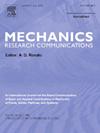横向荷载下拱的henky杆链模型振动分析
IF 2.3
4区 工程技术
Q3 MECHANICS
引用次数: 0
摘要
本研究的重点是利用Hencky杆链模型结合基于能量的方法推导出控制特征值方程,对荷载拱进行振动分析。该公式是全面的,适应任意拱形状,载荷和支撑条件,以及不对称或对称的振动模式。Hencky杆链模型通过将拱离散为由无摩擦铰链和弹性旋转弹簧连接的刚性段,将连续介质力学的复杂微分方程转化为可解的代数方程,便于结构振动的有效分析。这种通用框架解决了在荷载拱的振动分析中存在的差距。为了证明其适用性,本研究考察了圆形、抛物线形和三角形拱门在点荷载和分布荷载作用下的说明性案例,计算了它们的振动频率,以评估横向荷载量级对这些频率的影响。得到的精确振动频率可作为基准解,对验证新的解析公式和计算模型在拱的振动分析中有价值。本文章由计算机程序翻译,如有差异,请以英文原文为准。
Vibration analysis of transversely loaded arches using Hencky bar-chain model
This study focuses on the vibration analysis of loaded arches utilizing the Hencky bar-chain model in conjunction with an energy-based approach to derive the governing eigenvalue equations. The formulation is comprehensive, accommodating arbitrary arch shapes, loading and support conditions, and asymmetrical or symmetrical vibration modes. By discretizing the arch into rigid segments connected by frictionless hinges and elastic rotational springs, the Hencky bar-chain model transforms the complex differential equations of continuum mechanics into a solvable set of algebraic equations, facilitating efficient analysis of structural vibrations. This general framework addresses existing gaps in the vibration analysis of loaded arches. To demonstrate its applicability, the study examines illustrative cases involving circular, parabolic, and triangular arches subjected to point and distributed loads, calculating their vibration frequencies to assess the influence of transverse load magnitudes on these frequencies. The accurate vibration frequencies obtained serve as benchmark solutions, valuable for validating new analytical formulations and computational models in the vibration analysis of arches.
求助全文
通过发布文献求助,成功后即可免费获取论文全文。
去求助
来源期刊
CiteScore
4.10
自引率
4.20%
发文量
114
审稿时长
9 months
期刊介绍:
Mechanics Research Communications publishes, as rapidly as possible, peer-reviewed manuscripts of high standards but restricted length. It aims to provide:
• a fast means of communication
• an exchange of ideas among workers in mechanics
• an effective method of bringing new results quickly to the public
• an informal vehicle for the discussion
• of ideas that may still be in the formative stages
The field of Mechanics will be understood to encompass the behavior of continua, fluids, solids, particles and their mixtures. Submissions must contain a strong, novel contribution to the field of mechanics, and ideally should be focused on current issues in the field involving theoretical, experimental and/or applied research, preferably within the broad expertise encompassed by the Board of Associate Editors. Deviations from these areas should be discussed in advance with the Editor-in-Chief.

 求助内容:
求助内容: 应助结果提醒方式:
应助结果提醒方式:


